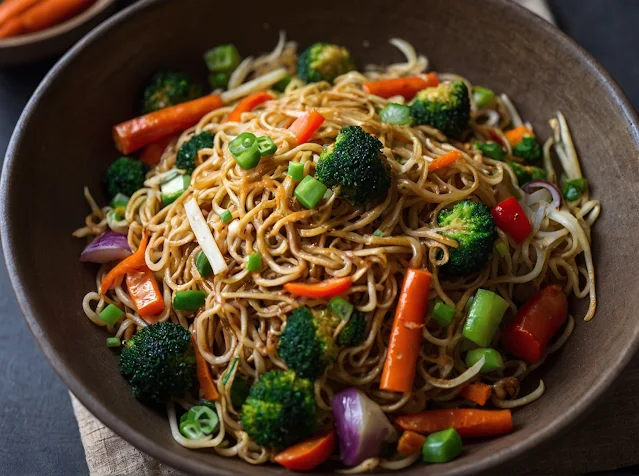Stir-fry noodles with vegetables is a well-rounded and tasty recipe that captures the delicate sweetness of mixed vegetables and the satisfaction of soft noodles. This culinary orchestration originates in the world of oriental dishes and has found its way into people's plates around the globe for the compelling and enrichment experience that it offers. This essay will talk about noodles stir-fried with vegetables, its nutritional qualities and its position as one of the indispensable departments of Chinese cuisine, with deep cultural roots.
1. The Allure of Stir-Fried Noodles with Vegetables:
To our smell, sight and touch, the aroma, vivid colors and pleasant textures of stir-fried noodles with vegetables lead us onto a very exciting detour. Together with vingette of the feelings, such as bell pepper, carrots, broken, and takeaways, bring crunch and texture to the dish. The consumption of these vegetables not only results in a dish that is visually attractive but also provides various varieties of flavors and important nutrients which are good for health.
This noodles both rice noodles, udon, or soba can be says the foundation of the dish, absorbing the sauce flavors and gives you good chewy as well. Stir-frying technique plays a role to allow the noodles are soaked with the savory sauce and to take up the rich essence of vegetables and seasonings which form a kind of bobble.
2. Nutritional Benefits:
A dish paired with stir-fried noodles and vegetables is a very vital source of nutrients. The variety of colors in the vegetables displays the diversity of nutrients, including vitamins, minerals and dietary fibers that ensure good health for body functioning. These nutrient dense ingredients promote digestion and level up our immune system too. Apart from that, these ingredients are beneficial antioxidants as well.
Also, the chosen noodles' role in the meal is to give the body some energy and carbohydrates, which are crucial for body fueling. It depends on which type of noodles is applied because, in the other case, there maybe nutritional benefits.Take, for example, rice noodles that are gluten-free. They can be eaten by persons on a gluten-free diet. On the other hand, whole wheat or buckwheat noodles can provide essential nutrients and even fiber.
3. Cultural Significance:
Stir-fried vegetables have noodles come in different Asian cuisines,such as Chinese, Thai and Japanese. These styles have, to a certain degree, perfected the method of stir frying and make use of a range of sauces and flavors to create distinctive tastes such that they derive their identity.
Stir-fried noodles have found their way into the hearts of Chinese cuisine and often are on the street food menus at the time of Chinese New Year celebrations. This dish is considered the food to bring health and longevity. Wok Thai food, such as Pad Thai, provides an illustration on how a wok-fried noodle with vegetables can deliver a combination of different flavors and textures. Not only is the noodle dish called Yakisoba emblematic of Japanese cuisine but also exemplifies the beauty and cleanness of its arrangement.
Stir-fried noodles along with vegetables bring an array of merry opposite, appearance and intentions. Ceses versatility makes it possible to have lots of substitutions inspiring diverse ones and ethnic cultures. The dish offers cooking to cooking tastes alongside; it is a complete and nutritious meal of vitamins, minerals, and fiber.
Therefore, whenever you are in the mood for a tasty and nice-tasting meal, choose the appeal of vegetable and noodles stir fry (also called a combination of fried meat and green leafy vegetables). Enjoy this Asian food to the fullest by taking in the vivid colors, appreciating the pleasant textures and understanding the great cultural impact.

